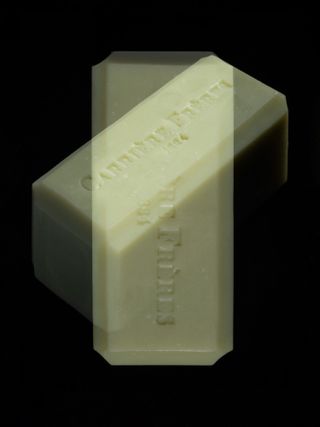Hygiene is considered to be something of a modern preoccupation, but there is evidence that soap was invented by ancient civilisations nearly 5,000 years ago. Archaeologists unearthed traces of it in Babylonian clay artefacts, which were also inscribed with recipes for soap-making.
In Aleppo, olive oil, laurel berry oil and lye were melted down, then cooled underground to form a vast, avocado-green sheet, a process that remains largely unchanged today. (Some myths recount Cleopatra bathing in milk, using Aleppo soap). Echoing this ancient wisdom, Santa Maria Novella – the oldest pharmacy in the world, with roots that trace back to 13th-century Florence – produces a buttery milk soap bar that is available unscented or containing botanical ingredients such as gardenia or verbena.

‘Bosci’ soap, £25, by Carrière Frères
(Image credit: Photography by Sophie Gladstone)
Why solid soap is the most pleasurable object to wash with
A bar of soap also recalls the midtwentieth century era, when brands such as Pears and Cussons would vie for airwave supremacy through their sponsorship of radio and TV programmes, leading to the shows being dubbed ‘soap operas’.
The celebrated 20th century photographer and society darling Cecil Beaton was once asked, ‘What is elegance?’, to which he simply replied, ‘Soap and water!’ One can imagine one of his muses – Maria Callas, Barbra Streisand, Baroness Fiona Thyssen-Bornemisza – returning to their bathrooms after a day shooting with Beaton and using a rose-scented Dior soap bar to dissolve heavy, camera-ready make-up. The house offers up a contemporary iteration of this product in its ‘Prestige Le Savon’ soap.

Fragranced soap, £87 for three, by Hermès
(Image credit: Photography by Sophie Gladstone)

‘Parade’ perfumed soap, £90 for three, by Celine
(Image credit: Photography by Sophie Gladstone)
Hedi Slimane also captures a sense of 20th-century nostalgia in his bath and body collection for Celine. The round soap medallions, engraved with the fashion house’s Triomphe motif, are fragranced with signature scents, from the citrus notes of Parade to the zesty, slightly sugary accord of Cologne Céleste.
‘Bathing is an essential gesture that systematically plunges me back into the soothing atmosphere of childhood,’ says Slimane. Rich in Parisian glamour, these soaps can also be slipped dry into drawers, infusing clothes and linens with their scent.

‘Prestige Le Savon’ soap, £85, by Dior
(Image credit: Photography by Sophie Gladstone)

‘Refresh’ body cleansing slab, £25, by Aesop
(Image credit: Photography by Sophie Gladstone)
Smooth, shiny and pebble-like, with branding satisfyingly embossed or debossed into its surface, a new bar of soap can conjure up similar emotions to those inspired by a freshly unwrapped chocolate bar. Perfume house Diptyque, in particular, has a knack for creating solid soaps that almost look too good to use. It can feel like a heart-wrenching act to gradually wash away the grooves of typography, watching them grow faint before the final act of disappearing entirely.
The ephemeral poetics of soap have not been lost on contemporary culture. For her 1993 piece Lick and Lather, performance artist Janine Antoni created 14 busts of her head and shoulders, seven in soap and seven in chocolate – she then licked the chocolate and bathed with the soap to reshape her image. Meanwhile, in Thomas Bärnthaler’s 2015 book Do It Yourself: 50 Projects by Designers and Artists, John Baldessari provided instructions on soap carving, in a work he called A Large Piece of Soap Becomes a Small Piece of Soap Eventually.

‘34 Boulevard Saint Germain’ scented soap, £33, by Diptyque
(Image credit: Photography by Sophie Gladstone)

‘Eau du Soir’ scented soap, £32, by Sisley
(Image credit: Photography by Sophie Gladstone)
At this year’s Salone del Mobile in Milan, Belgian architect Nicolas Schuybroek celebrated the form and functionality of soap in a collaboration with Aesop. His installation, Form Follows Formulation, used hundreds of the Australian skincare brand’s body cleansing slabs – which contain purifying oils, bergamot rind, ylang ylang and lime – to build a monolithic brickwork structure in Aesop’s Piazza Cordusio store, in the centre of which a treatment therapist performed a daily choreographed facial treatment.
‘Restricting materiality to something as simple as a soap bar resonates with the principles of the arte povera movement, while also echoing Superstudio’s iconic monochromatic grid structures from the 1970s,’ says Schuybroek.

‘Scent of Marihuana’ soap bar, £47, by Loewe
(Image credit: Photography by Sophie Gladstone)

‘Natural exfoliating bar’, £8, by Fussy
(Image credit: Photography by Sophie Gladstone)
Some designers have looked to combat the transient, slippery nature of solid soap by inviting it to inhabit the domestic landscape as both beauty product and decorative object. Loewe’s ‘Scent of Marihuana’ soap bar, which is studded with exfoliating particles of red algae and emits the soothing aroma of the sativa plant, can be decoratively hung using its integrated linen rope, in a similar way to the rotating, wall mounted soaps by French brand Provendi.
Liquids, gels and foams share a common goal: to sanitise, enveloping bacteria and microbes so they can then be washed away. But while a bar of soap is just as good at cleansing the skin, it can be so much more, creating a decadently pleasurable experience that’s been enjoyed for millennia.
This article appears in the September 2024 issue of Wallpaper*, available in print on newsstands, on the Wallpaper* app on Apple iOS, and to subscribers of Apple News +. Subscribe to Wallpaper* today.

Unscented milk soap, £12, by Santa Maria Novella
(Image credit: Photography by Sophie Gladstone)
